【语法】高中英语动词的时态和语态讲解
高中英语语法必备之谓语动词的时态和语态详解
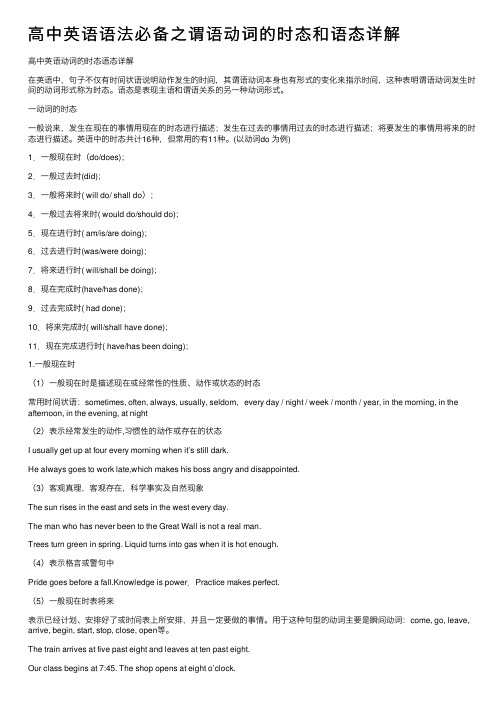
⾼中英语语法必备之谓语动词的时态和语态详解⾼中英语动词的时态语态详解在英语中,句⼦不仅有时间状语说明动作发⽣的时间,其谓语动词本⾝也有形式的变化来指⽰时间,这种表明谓语动词发⽣时间的动词形式称为时态。
语态是表现主语和谓语关系的另⼀种动词形式。
⼀动词的时态⼀般说来,发⽣在现在的事情⽤现在的时态进⾏描述;发⽣在过去的事情⽤过去的时态进⾏描述;将要发⽣的事情⽤将来的时态进⾏描述。
英语中的时态共计16种,但常⽤的有11种。
(以动词do 为例)1.⼀般现在时(do/does);2.⼀般过去时(did);3.⼀般将来时( will do/ shall do);4.⼀般过去将来时( would do/should do);5.现在进⾏时( am/is/are doing);6.过去进⾏时(was/were doing);7.将来进⾏时( will/shall be doing);8.现在完成时(have/has done);9.过去完成时( had done);10.将来完成时( will/shall have done);11.现在完成进⾏时( have/has been doing);1.⼀般现在时(1)⼀般现在时是描述现在或经常性的性质、动作或状态的时态常⽤时间状语:sometimes, often, always, usually, seldom,every day / night / week / month / year, in the morning, in the afternoon, in the evening, at night(2)表⽰经常发⽣的动作,习惯性的动作或存在的状态I usually get up at four every morning when it’s still dark.He always goes to work late,which makes his boss angry and disappointed.(3)客观真理,客观存在,科学事实及⾃然现象The sun rises in the east and sets in the west every day.The man who has never been to the Great Wall is not a real man.Trees turn green in spring. Liquid turns into gas when it is hot enough.(4)表⽰格⾔或警句中Pride goes before a fall.Knowledge is power.Practice makes perfect.(5)⼀般现在时表将来表⽰已经计划、安排好了或时间表上所安排,并且⼀定要做的事情。
2024高考英语语法知识点归纳总结动词的时态和语态
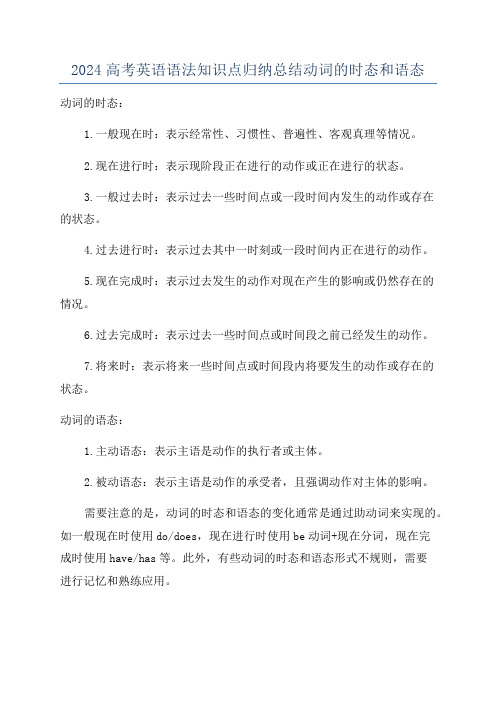
2024高考英语语法知识点归纳总结动词的时态和语态
动词的时态:
1.一般现在时:表示经常性、习惯性、普遍性、客观真理等情况。
2.现在进行时:表示现阶段正在进行的动作或正在进行的状态。
3.一般过去时:表示过去一些时间点或一段时间内发生的动作或存在
的状态。
4.过去进行时:表示过去其中一时刻或一段时间内正在进行的动作。
5.现在完成时:表示过去发生的动作对现在产生的影响或仍然存在的
情况。
6.过去完成时:表示过去一些时间点或时间段之前已经发生的动作。
7.将来时:表示将来一些时间点或时间段内将要发生的动作或存在的
状态。
动词的语态:
1.主动语态:表示主语是动作的执行者或主体。
2.被动语态:表示主语是动作的承受者,且强调动作对主体的影响。
需要注意的是,动词的时态和语态的变化通常是通过助动词来实现的。
如一般现在时使用do/does,现在进行时使用be动词+现在分词,现在完
成时使用have/has等。
此外,有些动词的时态和语态形式不规则,需要
进行记忆和熟练应用。
英语语法 动词时态和语态 详解
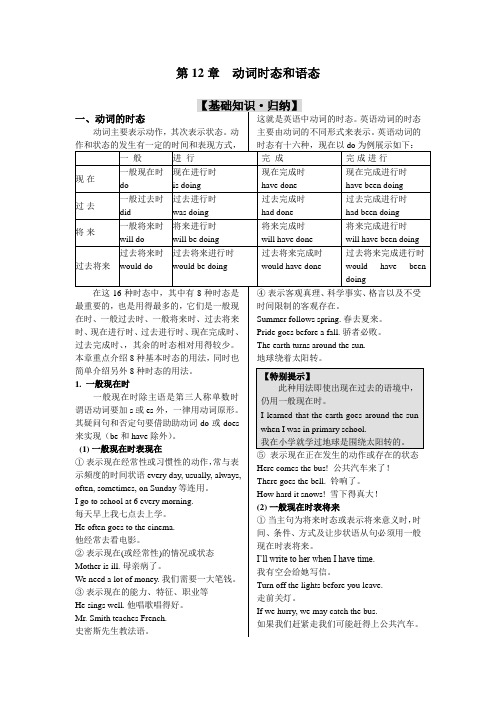
第 12 章动词时态和语态【基础知识·归纳】一、动词的时态动词主要表示动作,其次表示状态。
动 作和状态的发生有一定的时间和表现方式, 一 般 现在 过去 将来 一般现在时 do 一般过去时 did 一般将来时 will do 过去将来时 would do 进 行 现在进行时 is doing 过去进行时 was doing 将来进行时 will be doing 过去将来进行时 would be doing 这就是英语中动词的时态。
英语动词的时态 主要由动词的不同形式来表示。
英语动词的 时态有十六种,现在以 do 为例展示如下: 完 成 现在完成时 have done 过去完成时 had done 将来完成时 will have done 过去将来完成时 would have done 完成进行 现在完成进行时 have been doing 过去完成进行时 had been doing 将来完成进行时 will have been doing 过去将来完成进行时 would have been doing过去将来在这 16 种时态中,其中有 8 种时态是 最重要的,也是用得最多的,它们是一般现 在时、一般过去时、一般将来时、过去将来 时、 现在进行时、 过去进行时、 现在完成时、 过去完成时、 ,其余的时态相对用得较少。
本章重点介绍 8 种基本时态的用法, 同时也 简单介绍另外 8 种时态的用法。
1. 一般现在时 一般现在时除主语是第三人称单数时 谓语动词要加 s 或 es 外,一律用动词原形。
其疑问句和否定句要借助助动词 do 或 does 来实现(be 和 have 除外) 。
(1) 一般现在时表现在 ① 表示现在经常性或习惯性的动作, 常与表 示频度的时间状语 every day, usually, always, often, sometimes, on Sunday 等连用。
(完整版)高中语法之常用时态语态详解

第四章时态和语态一.动词的时态英语时态用共有十六种时态,其中常用的有8种,它们是:一般现在时、一般过去时、一般将来时、现在进行时、现在完成时、过去进行时、过去完成时和过去将来时。
一. 一般现在时.1.构成. be动词:am is are ; 其他动词用动词原形,当主语是第三人称单数时要在谓语动词后加“s”,其变化规则与名词变复数一致。
2.用法. 1). 经常性或习惯性的动作,常与表示频度的时间状语连用。
如usually, always, often, seldom, never, every...,eg. I leave home for school at 7 every morning.I don’t leave home for school at 7 every morning.Do I leave home for school at 7 every morning?He usually gets up early.He doesn’t usually get up early.Does he usually get up early?2) 客观真理,客观存在,科学事实。
eg. The earth moves around the sun.The earth doesn’t move around the sun 否定句Does the earth move around the sun? 疑问句Shanghai lies in the east of China.Shanghai doesn’t lie in the east of China 否定句Does Shanghai lie in the east of China? 疑问句Water boils at 100 centigrade degrees.3) 表示格言或警句中eg. Pride goes before a fall.注意. 此用法如果出现在宾语从句中,即使主句是过去时,从句谓语也要用一般现在时。
动词的时态和语态
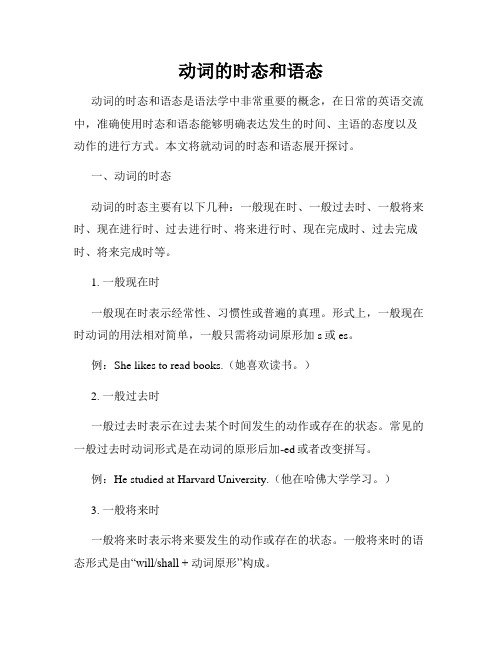
动词的时态和语态动词的时态和语态是语法学中非常重要的概念,在日常的英语交流中,准确使用时态和语态能够明确表达发生的时间、主语的态度以及动作的进行方式。
本文将就动词的时态和语态展开探讨。
一、动词的时态动词的时态主要有以下几种:一般现在时、一般过去时、一般将来时、现在进行时、过去进行时、将来进行时、现在完成时、过去完成时、将来完成时等。
1. 一般现在时一般现在时表示经常性、习惯性或普遍的真理。
形式上,一般现在时动词的用法相对简单,一般只需将动词原形加s或es。
例:She likes to read books.(她喜欢读书。
)2. 一般过去时一般过去时表示在过去某个时间发生的动作或存在的状态。
常见的一般过去时动词形式是在动词的原形后加-ed或者改变拼写。
例:He studied at Harvard University.(他在哈佛大学学习。
)3. 一般将来时一般将来时表示将来要发生的动作或存在的状态。
一般将来时的语态形式是由“will/shall + 动词原形”构成。
例:I will go to the park tomorrow.(明天我将去公园。
)4. 现在进行时现在进行时表示正在进行的动作。
现在进行时的时态形式是由“be 动词(am/is/are)+动词-ing形式”构成。
例:They are playing basketball now.(他们现在正在打篮球。
)5. 过去进行时过去进行时表示过去某个时间正在进行的动作。
过去进行时的时态形式是由“was/were + 动词-ing形式”构成。
例:He was studying at the library yesterday.(昨天他在图书馆学习。
)6. 将来进行时将来进行时表示将来某个时间正在进行的动作。
将来进行时的时态形式是由“will be + 动词-ing形式”构成。
例:They will be traveling to Europe next month.(他们下个月将要去欧洲旅行。
高中英语知识点归纳动词的时态与语态
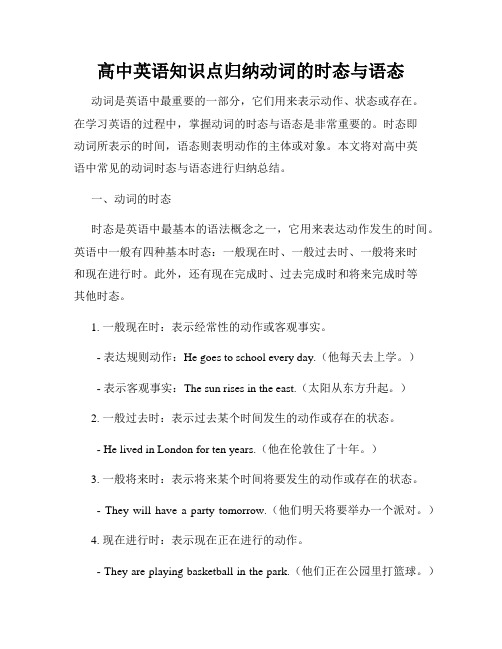
高中英语知识点归纳动词的时态与语态动词是英语中最重要的一部分,它们用来表示动作、状态或存在。
在学习英语的过程中,掌握动词的时态与语态是非常重要的。
时态即动词所表示的时间,语态则表明动作的主体或对象。
本文将对高中英语中常见的动词时态与语态进行归纳总结。
一、动词的时态时态是英语中最基本的语法概念之一,它用来表达动作发生的时间。
英语中一般有四种基本时态:一般现在时、一般过去时、一般将来时和现在进行时。
此外,还有现在完成时、过去完成时和将来完成时等其他时态。
1. 一般现在时:表示经常性的动作或客观事实。
- 表达规则动作:He goes to school every day.(他每天去上学。
)- 表示客观事实:The sun rises in the east.(太阳从东方升起。
)2. 一般过去时:表示过去某个时间发生的动作或存在的状态。
- He lived in London for ten years.(他在伦敦住了十年。
)3. 一般将来时:表示将来某个时间将要发生的动作或存在的状态。
- They will have a party tomorrow.(他们明天将要举办一个派对。
)4. 现在进行时:表示现在正在进行的动作。
- They are playing basketball in the park.(他们正在公园里打篮球。
)5. 现在完成时:表示过去某个时间开始的动作一直持续到现在,或者强调过去的动作对现在造成的影响。
- I have finished my homework.(我已经完成了作业。
)6. 过去完成时:表示过去某个时间之前已经发生的动作。
- He had already left when I arrived.(我到达时他已经离开了。
)7. 将来完成时:表示将来某个时间之前已经完成的动作。
- By this time next year, I will have graduated from university.(到明年这个时候,我将已经大学毕业了。
高中英语知识点归纳动词的语态与时态

高中英语知识点归纳动词的语态与时态动词的语态与时态是高中英语学习中的重点难点之一。
正确掌握动词的语态与时态,不仅可以提高英语写作和阅读的能力,还能帮助我们更好地理解英语语法和文化。
本文将系统性地对动词的语态与时态进行归纳总结,旨在帮助高中生更好地掌握这一知识点。
一、动词的语态动词的语态主要分为主动语态和被动语态两种。
1. 主动语态(active voice)在主动语态中,主语是动作的执行者或者发出者。
主动语态通常由主语+及物动词+宾语构成。
例如:- She writes a letter.(她写了一封信。
)- They are building a new house.(他们正在盖一座新房子。
)- We have eaten dinner.(我们已经吃晚饭了。
)2. 被动语态(passive voice)在被动语态中,主语是动作的承受者或者接受者。
被动语态通常由宾语+及物动词+be动词+过去分词构成。
例如:- A letter is written by her.(一封信被她写了。
)- A new house is being built by them.(一座新房子正在被他们建造。
)- Dinner has been eaten by us.(晚饭已经被我们吃了。
)要注意的是,被动语态中的宾语在主动语态中通常是作为及物动词的宾语出现的。
同时,被动语态还可以通过不定式或现在分词的形式进行表达。
例如:- The meeting is to be held tomorrow.(会议将于明天举行。
)- The book left on the desk is mine.(留在桌子上的书是我的。
)二、动词的时态动词的时态主要包括一般现在时、一般过去时、一般将来时、现在进行时、过去进行时、过去将来时、现在完成时、过去完成时等。
1. 一般现在时(simple present tense)一般现在时表示现在经常或习惯性发生的动作或存在的状态。
(完整)高中英语语法(时态和语态)
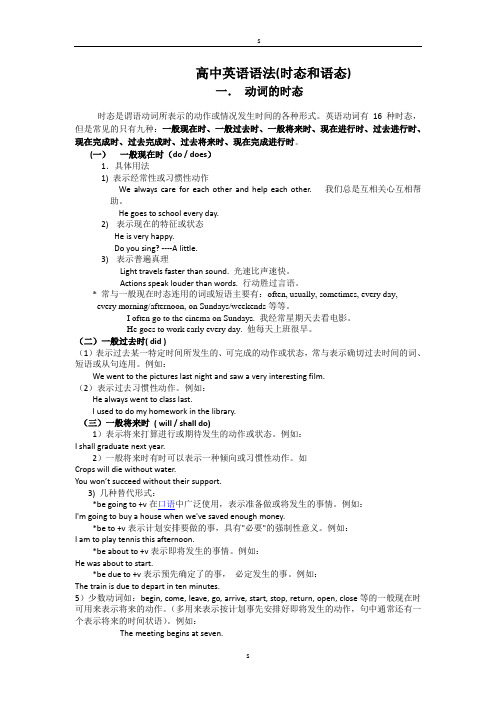
高中英语语法(时态和语态)一.动词的时态时态是谓语动词所表示的动作或情况发生时间的各种形式。
英语动词有16种时态,但是常见的只有九种:一般现在时、一般过去时、一般将来时、现在进行时、过去进行时、现在完成时、过去完成时、过去将来时、现在完成进行时。
(一)一般现在时(do / does)1.具体用法1) 表示经常性或习惯性动作We always care for each other and help each other. 我们总是互相关心互相帮助。
He goes to school every day.2)表示现在的特征或状态He is very happy.Do you sing? ----A little.3)表示普遍真理Light travels faster than sound. 光速比声速快。
Actions speak louder than words. 行动胜过言语。
* 常与一般现在时态连用的词或短语主要有:often, usually, sometimes, every day,every morning/afternoon, on Sundays/weekends等等。
I often go to the cinema on Sundays. 我经常星期天去看电影。
He goes to work early every day. 他每天上班很早。
(二)一般过去时( did )(1)表示过去某一特定时间所发生的、可完成的动作或状态,常与表示确切过去时间的词、短语或从句连用。
例如:We went to the pictures last night and saw a very interesting film.(2)表示过去习惯性动作。
例如:He always went to class last.I used to do my homework in the library.(三)一般将来时( will / shall do)1)表示将来打算进行或期待发生的动作或状态。
- 1、下载文档前请自行甄别文档内容的完整性,平台不提供额外的编辑、内容补充、找答案等附加服务。
- 2、"仅部分预览"的文档,不可在线预览部分如存在完整性等问题,可反馈申请退款(可完整预览的文档不适用该条件!)。
- 3、如文档侵犯您的权益,请联系客服反馈,我们会尽快为您处理(人工客服工作时间:9:00-18:30)。
动词的时态和语态用法详解在英语中,不同时间里发生的动作或存在的状态需要用动词的不同形式表示出来,动词的这种不同形式就构成了动词的时态。
英语中的时态按动作发生时间分为现在时态、过去时态、将来时态一、时态的分类和基本构成形式二、常见时态的基本用法1. 一般现在时:一般现在时是描述现在或经常性的动作性质或状态的时态。
常和表示频率、时间的副词(短语)always, every time, now and then, occasionally, often, seldom, sometimes, usually等连用。
1)表示经常性或习惯性的动作。
We have three meals a day.2)表示客观事实、真理和自然现象。
Knowledge is power.3)表示现在的情况或状态。
I live in Beijing.4)表示已经“列入日程”的将来的事件,尤其指计划中的和安排好的将来的动作,这些动词往往表示“出发,到达”等含义的词,如,arrive, begin, go, leave, start, stay等。
The train arrives at 10:30. There's plenty of time. 。
考点一:表示永恒的真理,即使出现在过去的语境中,仍用一般现在时。
如:I learned that the earth goes around the sun when I was in primary school.考点二:在时间和条件状语从句中,代替一般将来时;常用的引导词有:时间:when, until, after, before, as soon as, once, the moment/the minute, the day; 条件:if, unless, provided.If he accepts the job, he will get more money soon.考点三:在make sure (certain), see to it, mind, care, matter +宾语从句,从句用一般现在时代替一般将来时。
So long as he works hard, I don’t mind when he finish es the experiment.考点四:在the more… the more … (越……越……) 句型中, 若主句是一般将来时, 从句通常用一般现在时。
The harder you study, the better results you will get.2. 一般过去时:一般过去时表示过去发生的动作、存在的状态,或反复发生的动作,句中一般都有表示过去具体时间的时间状语。
1)在确定的过去时间里所发生的动作或状态。
此时与表示过去的时间状语连用,如yesterday, last week, an hour ago, the other day, in1998等。
Where did you go yesterday??2)表示在过去一段时间内,经常性或习惯性的动作。
When I was a child, I often played football in the street.3)用在条件句中表示与现在或将来事实不符的虚拟语气。
If he were here now, we could turn to him for help.4)句中有延续性时间状语,但表示与现在没有关联的过去某段时间做了某事,此时用一般过去时。
This is the primary school where our manager Mr. Smith studied for six years.3. 一般将来时:一般将来时用来表示将要发生的事。
1)shall用于第一人称,常被will代替。
will在陈述句中用于各人称,在征求意见时常用于第二人称。
will (shall) + 动词原形There is still much to discuss. We shall return to this item at our next meeting.2)be going to + 动词原形,表示将来。
(1)主语的意图,即将做某事或打算做某事。
What are you going to do this Sunday morning?(2)计划、安排要发生的事。
I'm going to the airport to pick up my aunt from America this afternoon.(3)有迹象要发生的事。
Look at the dark clouds; there is going to be a storm.注意:be going to与will的区别be going to既可指主观打算做某事,也可指客观迹象表明将要发生某事;will往往指没有经过计划而临时出现的意图,常伴有说话者的主观意识或表示将来必然发生的事。
I'm going to quit my present job. (现在的打算,事先经过思考,指向将来)I'll answer the door. (未经事先考虑的意图)The little boy is going to fall over. (根据客观迹象判断)I hope it will be fine tomorrow. (主观意愿)3)“be + 不定式”表将来,表示按计划安排的事或按职责、义务或要求必须去做的事等。
We are to discuss the report next Saturday.The meeting is to take place at 8:00 tomorrow morning.注意:be to 和be going to的用法比较be to表示客观安排或受人指示而做某事。
I am to play football tomorrow afternoon. (客观安排)be going to则表示主观的打算或计划。
I am going to play football tomorrow afternoon. (主观安排)4)“be about to do”意为“马上做某事”,表示即将发生某事,该事将发生在很近的将来,不能与tomorrow, next week等表示明确将来的时间状语连用。
He is about to leave for Beijing.考点一:一般将来时总是用在一些时间状语从句或条件状语从句的主句中:We will begin our class as soon as the teacher comes.(主句用一般将来时,从句中一定要用一般现在时替代一般将来时。
)考点二:某些表示短暂性动作的动词如arrive, come, go, leave, start等,用现在进行时形式表示将来。
I am leaving for Beijing tomorrow.考点三:“祈使句+ and/or + 句子”,这种结构中and后面的句子谓语用一般将来时。
Use your head and you will find a way.4. 过去将来时:过去将来时表示从过去某一时间看将要发生的动作或存在的状态。
注意:这种时态常用于主句是一般过去时的宾语从句中,表示从句的动作发生在主句之后。
过去将来时同一般将来时类似,除了用would do 表示外,也可以用be going to do, be to do, be about to do及过去进行时等方式表示。
He was sixty-eight and in two years, he would be seventy.You were going to give me your address but you didn't.I was about to turn on the power of the computer when the electricity was cut off.完成体:现在完成时、过去完成时、将来完成时和过去将来完成时1. 现在完成时:常用的时间状语有:so far, recently, lately, before, ever, by now, in thelast/ past few years, over a long time, up to now,yet, already, just, since, for+ 一段时间等。
1)表示说话之前已经完成的动作,常与already, yet, just, by this time,so far, by now等时间状语连用。
此时句子中的谓语动词一般为非延续性动词且句子一般不与表示“一段时间”的时间状语连用。
Have you finished your task yet?注意:have gone to与have been to的区别have gone to 表示“到某地去了”,人可能还在路上,也可能已经到达,但一定不在说话者这里。
have been to 表示“去过某地”,是回来之后再谈论去过某地的情况。
2)表示过去发生的某一动作对现在造成的影响或结果。
He has lost his wallet and can't find it.3)表示从过去某一时间开始一直持续到现在的动作或状态。
They have been good friends since they met at a meeting.4)表示动作反复发生,句中常用once/ twice/ three... times 等。
You needn't describe her. I have met her many times.5)在时间或条件状语从句中表示在将来某个时间之前要完成某个动作。
Don't get off until the bus has stopped.注意:常用现在完成时的句型有:1)It is/has been + 一段时间+ since 从句;2)This/ That/ It is the first/ second... Time + that从句(从句用现在完成时);3)It/ This is the best/ worst/ most interesting + 名词+ that从句(从句用现在完成时)关于现在完成时的时间状语问题:A.现在完成时的句子里,不可以带有表示具体过去时间的状语,比较:We have bought a new typewriter .We bought a new typewriter yesterday.B. 在以when提问的特殊疑问中不能用现在完成时。
